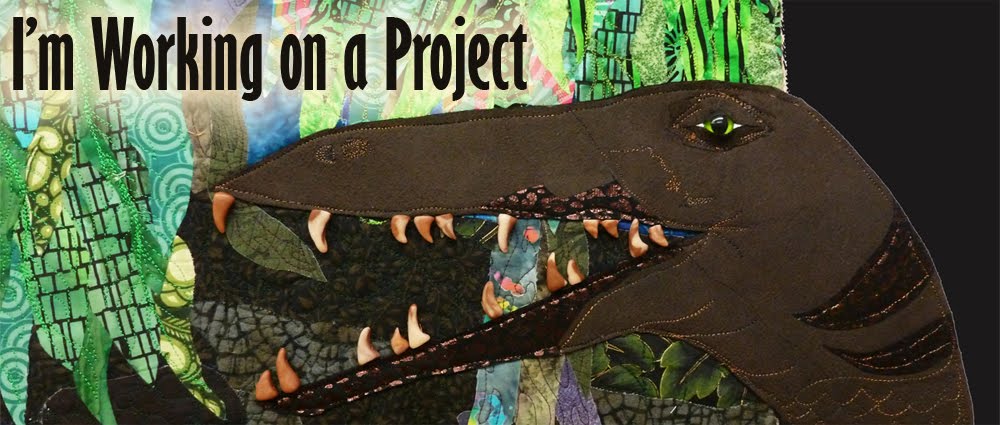After my last post about the Two Blind Mice quilt, Gwyned asked me if I'd share a few more technical details. After writing a long e-mail to her, I thought maybe some others would be interested so decided to share another post. She specifically asked about my process for the cutouts, binding, and hanging on this one, so here goes.
For these pieces where I have cutouts, I use synthetic fabrics for the front and back and synthetic (polyester) batting. Next I outline the area to be cut out with cotton thread before quilting the rest of it. Usually I quilt the whole sandwich, but in this case where I was cutting away most of it (i.e. the cutouts were as big or bigger than what was left behind) I just quilted inside my cotton outlines. Then I cut away the area near but not quite touching the cotton outline threads (through all three layers). This time since the pieces were big I cut away using scissors, but in the past when the cutouts have been smaller and fiddly I've used an exacto knife.
Then I use a woodburning tool to go along all the raw edges. The synthetic fabric and batting melt back to the cotton thread (which won't melt) leaving a sealed edge behind. This approach works pretty well for organic shapes, but not quite so well if you want precise geometric shapes or very straight lines (I guess for that a facing would give a crisper edge but I've never faced my cutouts). Just be careful to have lots of ventilation since the fumes from the melting polyester aren't healthy.
For this one where the cutout section was then cut in two and then bound, I carefully flattened out the large cut out piece and trimmed it to the right size. Getting the binding stitched on was a pain, but I just laid out the binding strip and put a tiny dot of water soluble glue on each of the floppy arms that was sticking out. Just to be double sure they didn't move (I was really worried that the arms would shift while I was sewing the binding strip on and then everything would pull funny), I put a tiny binder clip holding the binding at each place where there was an arm. I tried pins, but everything was way to thick and small to pin precisely. I then sewed the binding on by machine to the front (just like a normal binding). The only difference was that I did it in strips, that is I did all the long edges as individual strips and then did the cross pieces (see in picture below). This means there are no mitered binding corners, but I just tried to make the corners neat looking with no raw edges. I then flipped the binding strips around just like normal and hand stitched them down. That part wasn't hard, but I tried to be careful and make nice stitches (since they are visible in those open cutouts) and make sure that the raw edges of the binding were tucked inside in those open areas. The raw edges kept flipping out without a quilt edge to fold against.
To hang it, I put small straight sections of wire clothes hanger inside the binding across the top edges where the corners were inclined to flop, and then stitched a normal pocket across that center section. It'll now hang from a "regular" slat in the pocket, albeit one that's only the width of the center section rather than the whole quilt, and the corners won't droop because of the bits of wire in there.
Hope this is helpful to anyone thinking about trying cutouts! Always feel free to ask if you have any questions, I'm happy to share my trial and error process!

























